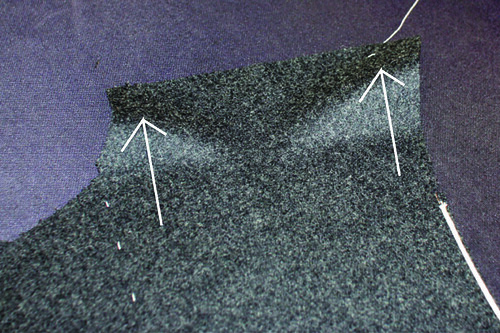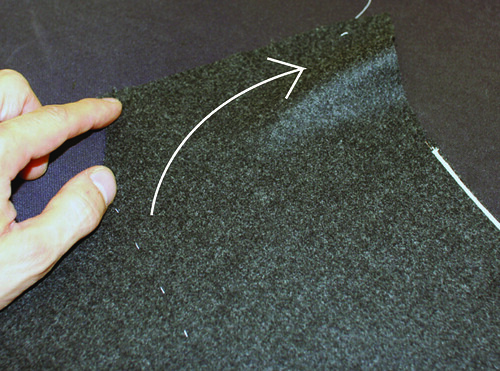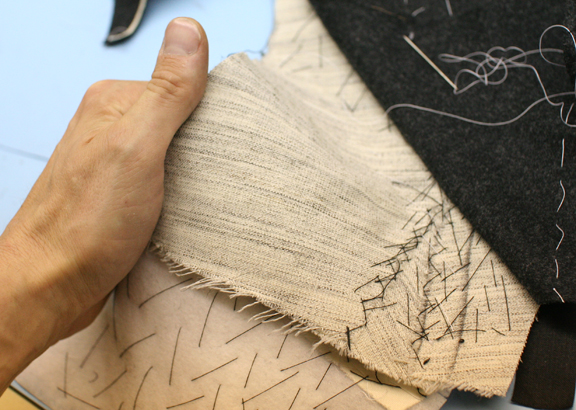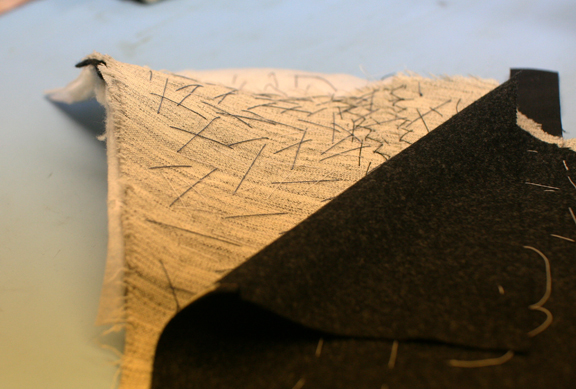We’ve seen the shaping that goes into the canvas. We’ve seen the shaping that goes into the pad. Everything that was done to these bits has to be done to the cloth too, but we don’t have the luxury of cuts or darts to impart the shape. This is the part that freaks out some novices, and the thing that makes this kind of shoulder really bad news for factories.
To get the kind of forward pitch and concavity, the neck area has to be stretched (think about the little wedge inserted in the perk) and the scye has to be stretched. How much? Well, that’s a tough one to answer. Enough. Not too much. Start by stretching the neck area, about ¼ to 3/8”, then do the same at the scye area. This should give two distinct ripples of length and a hollow area near the center. Look familiar? It should. Once they have been stretched with the iron, work the fullness toward the shoulder and give the neck another press to set it; the shape must match that of the canvas. 

The thing is, when you are stretching all this, you are lengthening the front a bit and thus throwing the balance slightly which will be adjusted during a fitting; you are also changing the scye measurement so the sleeve has to be adjusted accordingly, and refitted by basting, checking, adjusting, rebasting…… just the sort of thing that is anathema to a factory. That’s why you almost never see this type of shoulder except on the highest-end RTW.
So once you are ready to baste the front to the canvas, the first line of basting starts with a little pinch of fullness at the top- it is crucial that there be enough length for the cloth to be worked over the shoulder- if it is tight, the shoulder will kick backwards a bit.
Once the front is basted to the canvas, place the pad in position, flat on a table, lining up the shoulder seams. Baste in a semi-circle along the outer edge of the pad.
Now reach under and give the pad a yank- this will open up the cut we made in the chest piece, and give the concavity we want. Holding this shape, pad stitch through all layers from the outer edge of the pad toward the top of the shoulder. Keep this shape carefully because by pad stitching we are permanently setting the shape, the same was the lapel is rolled using the pad stitch.
When it’s finished, you will have the concavity of the pagoda shape and the natural forward pitch of the shoulder. 
Still with us, Karen?








5 comments:
I'm with you! I'm actually making a tuxedo with a slight pagoda shoulder and your blogtorial is not only informative, it's extremely timely!
Well good luck Adam- a tux with that shoulder will be a fun challenge! Let us know how you get on!
J
Still here, but a bit behind. I didn't quite realize how big a question this really was! Thank you for taking the time (and effort) to detail it for me. I can see why this isn't often used.
frank shattuck is interested in talking to you 315 882 4724
in this case, are we putting the pad which front is longer than the back?
Post a Comment